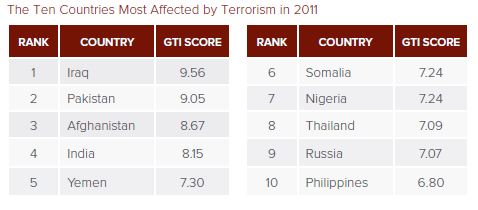Study: Fighting Terrorism With Military Almost Never Works
Remember when the George W. Bush campaign and the Republican Party was attacking John Kerry during the 2004 campaign over comments where they construed as him saying that terrorism is a police matter? Here’s a refresher:
Bush campaign Chairman Marc Racicot, in an appearance on CNN’s “Late Edition,” interpreted Kerry’s remarks as saying “that the war on terrorism is like a nuisance. He equated it to prostitution and gambling, a nuisance activity. You know, quite frankly, I just don’t think he has the right view of the world. It’s a pre-9/11 view of the world.”
Republican Party Chairman Ed Gillespie, on CBS’ “Face the Nation,” used similar language.
“Terrorism is not a law enforcement matter, as John Kerry repeatedly says. Terrorist activities are not like gambling. Terrorist activities are not like prostitution. And this demonstrates a disconcerting pre-September 11 mindset that will not make our country safer. And that is what we see relative to winning the war on terror and relative to Iraq.”
The Institute for Economics and Peace, a nonpartisan think tank in Australia, just issued its latest Global Terrorism Index. Buried deep in the report (pdf), on page 56, is this figure in which they summarize data from a RAND Corporation report:
The figure summarizes RAND Corporation findings from a study of 40 years of data on terrorist groups and how the terror activities of those groups come to an end. Despite the gargantuan US Great War on Terror with its trillions of dollars wasted and hundreds of thousands of people killed, only seven percent of the time when a terrorist group ends its activities is that due to them being defeated militarily. In fact, since they cease ten percent of the time due to achieving their goals, it can be argued that a military approach alone makes it more likely the terrorists will win than lose. The leading way for terrorist groups to cease their activities is for them to become a part of the political process, at forty-three percent. And gosh, it turns out that Kerry was correct, because police action (which in this study means “policing and intelligence agencies breaking up the group and either arresting or killing key members”) was the cause forty percent of the time when terrorist groups stop using terror. Oh, and adding further to the importance of policing, the report also states elsewhere that homicide accounts for forty times more deaths globally than terrorism.
As we saw in a previous report on the Global Terrorism Index, once again the countries in which the US GWOT is most active are those that have the worst ratings for terrorism. The list is headed by Iraq, with Afghanistan in the second position, Pakistan third and Syria fifth.
Not only are the countries where the US is actively militarily at the top of the index, the timeline of terror attacks provides a very strong correlation for the jump in global terror activity being triggered by the US invasion of Iraq in 2003:
The timeline seems to suggest that terror attacks were going back down after the 9/11 large event, but then took off after the US invaded Iraq.
Not only should the US learn from this report that the “military only” approach to terrorism is dead wrong, but there are warnings that the US should heed about domestic conditions as well. Here is how the study assesses the risk for future terrorism events:
Using terrorist incidents and events data dating back to 1970 and comparing it to over 5,000 socio-economic, political and conflict indicators, three groups of factors related to terrorist activity have been identified. Countries that are weak on these factors and do not have high levels of terrorism are assessed as being at risk.
The correlations section of this report details the most significant socio-economic correlates with terrorism. There are three groups of factors:
Social hostilities between different ethnic, religious and linguistic groups, lack of intergroup cohesion and group grievances.
Measures of state repression such as extrajudicial killings, political terror and gross human rights abuses.
Other forms of violence such violent crime, organised conflict deaths and violent demonstrations.
It sure sounds to me like a lot those boxes get checked when we start talking about what is going on in Ferguson, Missouri.




